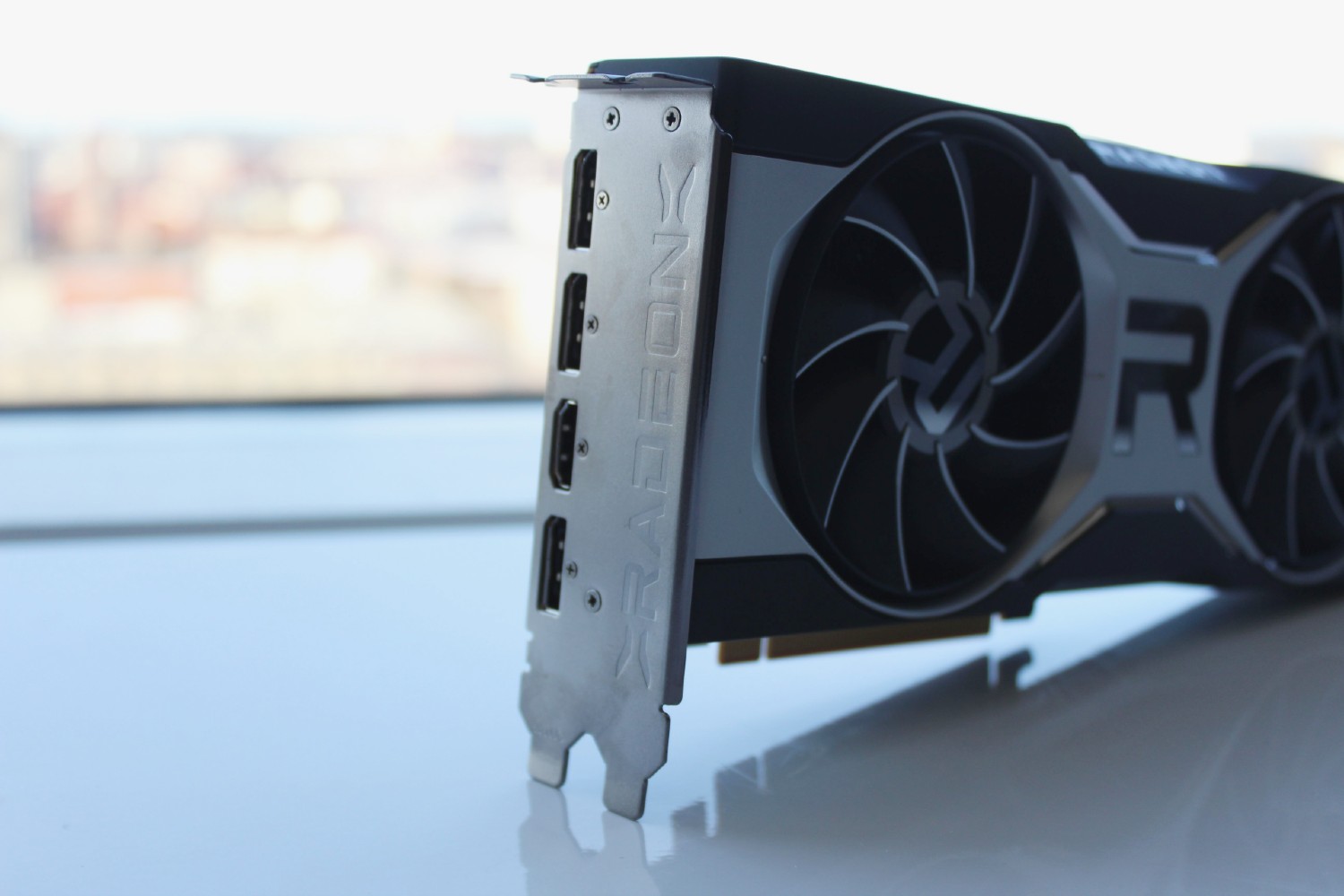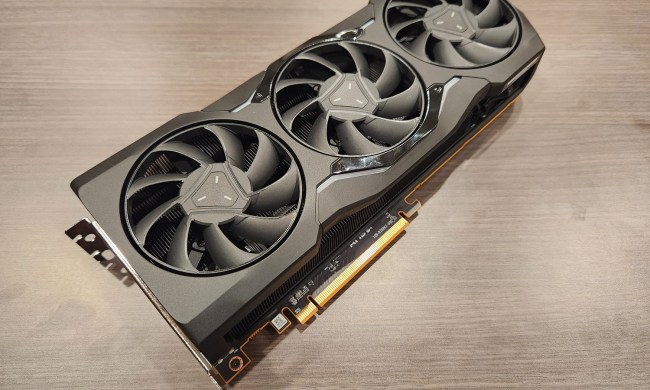It’s easy to write off new graphics card launches right now. Companies like Nvidia and AMD have been enjoying record demand, while the average PC gamer still can’t upgrade their system — at least not without paying way more than they should. Grumpiness is warranted.
But the AMD Radeon RX 6700 XT has launched, with sales opening up on March 18. I’m not here tell you whether or not you’ll be able to buy this card, especially not at its $479 official price. You’ll likely need to get very lucky — at least for the foreseeable future.
But beyond availability, there are real questions to answer about just how AMD’s graphics architecture compares against Nvidia’s.
How does it do? Well, it just might be the best proposition for straying away from Nvidia so far.
Design

The reference designs of AMD’s RX 6000-series cards aren’t my favorite. The light silver color and angled lines are a far cry from Nvidia’s more minimalist approach with Nvidia’s RTX 30-series. It’s a design aesthetic pulled from yesteryear, even compared to how last year’s RX 5000-series cards were dressed up.
Suffice it to say, I prefer Nvidia’s look. The RX 6700 XT looks a bit cheap next to it.
But once I popped the RX 6700 XT into my test kit, I was happy enough to enjoy the red outline and light-up Radeon logo along the top.
The RX 6700 XT is a blower-style card with a dual-fan setup, much like the Nvidia RTX 3070. This is, however, one less fan than the RX 6800 XT and what many of the partner cards will have. On the bottom, you’ll find a silver backplate that covers the circuit board, which is what you’d expect in a reference card.

The GPU draws power from a 6-pin and 8-pin PCIe power connector, which make it a clean and accessible upgrade. All of Nvidia’s 30-series cards require a cumbersome adapter.
Around back, the RX 6700 XT also has three DisplayPort 1.4 ports and one HDMI 2.1 for connecting to a monitor or TV. HDMI 2.1 lets you run 8K displays up to 60Hz or 4K displays up to 120Hz. That is, as long as you have the right cable and display to make use of it. This matches exactly what you get on the Nvidia side of things.
Specs and architecture
The RX 6700 XT is built on AMD’s Navi RDNA 2 architecture, the same as the other RX 6000-series cards released so far. These have been a significant improvement over the original RDNA cards, but how they stack up against Nvidia’s offerings can be a trickier proposition.
The RX 6700 XT is a new GPU, though — a different cut of silicon than what’s in the 6800 XT and 6900 XT. The result is a bigger difference in performance between the 6700 XT and 6800 than between any other AMD cards in the lineup so far.
Here’s how the specs break down in the lineup:
| Compute Units | Shading units | Clock speed | Boost speed | Memory capacity | TDP | Price | |
| Radeon RX 6700 XT | 40 | 2560 | 2.3GHz | 2.4GHz | 12GB | 230w | $480 |
| Radeon RX 6800 | 60 | 3840 | 1.8GHz | 2.1GHz | 16GB | 250w | $580 |
| GeForce RTX 3070 | 36 | 5888 (Cuda) | 1.5GHz | 1.7GHz | 8GB | 220w | $500 |
| GeForce RTX 3060 Ti | 38 | 4864 (Cuda) | 1.4GHz | 1.6GHz | 8GB | 200w | $400 |
| Radeon RX 5700 XT | 40 | 2560 | 1.6GHz | 1.9GHz | 8GB | 225w | $400 |
In terms of price, the RX 6700 XT lands $20 below the well-received Nvidia RTX 3070. It’s 20% cheaper than its big brother, the RX 6800, while having 10% less shading units. That’s a good sign for performance-per-dollar comparisons.
The increase in clock speed and memory capacity is worth noting, though. AMD is selling this as a high refresh rate 1440p card, and the 4GB of extra video memory over the RTX 3070 should help in those higher resolutions.
Still, it has its work cut out for it if it wants to dethrone the RTX 3070 in this price category.
Game performance
I tested the RX 6700 XT in a rig set up with 32GB of RAM, a 750-watt power supply, and an Intel Core i9-10900K. Right off the bat, that means Smart Access Memory wasn’t something I was able to test. The feature works only with all-AMD setups and only in some games — and let’s be honest, that’s not where most gamers are at.
It’s an interesting technology, though, that AMD says can add up to an extra 15% of performance in games.

I did test 3DMark Time Spy and Fire Strike, as well as an assortment of modern games. This ends up being the first casualty against the RX 6700 XT. The RTX 3070 gets a solid 13% higher score. The 6700 XT was 15% better than last year’s Nvidia RTX 2070 Super, though, and 20% better than the RX 5700 XT.
The tables turn in 3DMark Fire Strike, though, which is an older DX11 benchmark. Here, the RX 5700 XT beats the RTX 2070 Super, and likewise, the RX 6700 XT beats the RTX 3070.
Next, I tested out the cards in Assassin’s Creed Valhalla, Fortnite, Battlefield V, and Civilization VI. As stated, the RX 6700 XT is meant to be a strong 1440p card, and AMD delivers on exactly that promise. It played all games I tested at well over 60 frames per second (fps), with many getting closer to 144 fps. These are important thresholds to keep in mind when you’re thinking about what your gaming monitor can support.
Across the board, the RX 6700 XT competes surprisingly well with the RTX 3070 for $20 cheaper.
Assassin’s Creed Valhalla‘s in-game benchmark played in 1440p at Ultra High settings at a smooth 75 fps, which is 30 fps faster than the 5700 XT. That’s a huge gain in a very heavy game to render. Importantly, it also just barely nudges past the RTX 3070, which is an impressive feat. Of course, many will choose to play at 1080p, where you can average an even smoother 100 fps.
But really, that’s the only game where 1080p will be much of a consideration. In Battlefield V, the RX 6700 XT averaged 130 fps in 1440p Ultra. The RTX 3070 took its largest lead here, beating the 6700 XT by around 12%. Meanwhile, in Fortnite, the 6700 XT averaged 121 fps at 1440p Epic settings, which was neck and neck with the RTX 3070.
While you certainly can jump to 4K in these lighter games, 1440p is really the sweet spot for this card in terms of balancing fidelity and frame rate. The one exception to that rule was Civilization VI, which is a game that really benefits from the high resolution. Here, the RX 6700 XT was able to deliver a frame rate of 115 fps — which is plenty high for a strategy game like Civilization VI.

Across the board, the RX 6700 XT competes surprisingly well with the RTX 3070 for $20 cheaper. Those scores and frame rates had me cheering for Team Red, which is clearly still the underdog in this race.
Throughout, the RX 6700 XT consistently runs hotter than Nvidia’s RTX 30-series, sometimes by an average of as much as 10 degrees Celsius. I never saw temperatures peak over 76 degrees, which is in line with other RX 6000 and 5000-series cards.
I did, however, see frequencies boosting as high as 2.59GHz without overclocking, measuring up to the claims AMD makes in its spec sheets. These are the highest frequencies I’ve tested on a graphics card out of the box, and are doubt the reason for the RX 6700 XT’s great performance.
Ray tracing performance, though, made me less excited. I tested out some of the ray tracing settings in Fortnite, which allow for a fairly granular amount of control. But even playing at 1080p High made
How far behind is AMD in this regard? For reference, even last year’s RTX 2070 Super outpaced it with these same settings, averaging 78 fps with global illumination turned off (and the other settings at low). You can do better if you flip on DLSS too, which the AMD card lacks.
Overall, ray tracing still isn’t a great experience in a game like Fortnite unless you have the absolute top-end graphics card in your rig. Even still, I’d prefer the higher resolutions and frame rates in these faster-paced games. If you have any desire at all to play around with
Content-creation performance

As has been the case with most AMD graphics cards of late, content creation hasn’t been a strong suit. Nvidia’s Cuda graphics API performs beautifully in many professional creative applications, and I wanted to see how the RX 6700 XT compared. It wasn’t pretty.
Let’s start with the Blender benchmark, which tests performance in 3D modeling. The RX 6700 XT completed the first rendering in 57 seconds, which was 15 seconds faster than the 5700 XT, or 20% faster. That’s a solid generational leap. But compared to even the $329 Nvidia RTX 3060, it couldn’t keep up. That card finished the same rendering in just 49 seconds. You can imagine how far ahead the RTX 3060 and RTX 3070 would be.
I made this same comparison in the PugetBench for Adobe Premiere Pro benchmark, which tests the system in tasks like 4K playback and video encoding. The RX 6700 XT did a bit better here, but still scored slightly behind the RTX 3060 in the benchmark’s GPU rating.
Clearly, if you want to use your expensive GPU for something other than gaming, one of Nvidia’s options provides a better value. With the gaming performance a bit more even, that could be the tipping point for many potential buyers. Throw in better ray tracing performance and you have a situation where becomes hard to recommend the RX 6700 XT, despite how impressive the raw 1440p gaming strength is.
Don’t get me wrong — if you can find one of these at a retailer when they go on sale on March 18 — by all means, pick it up. It plays games beautifully in 1440p. But once supply normalizes and we’re left with two clear options, Nvidia’s 30-series cards will continue to be the more well-rounded purchase.



